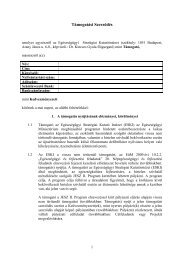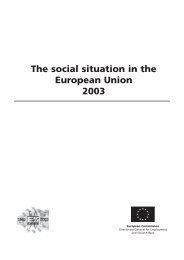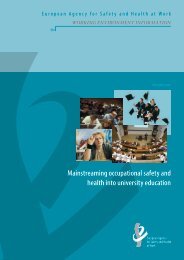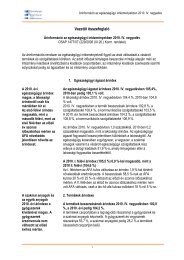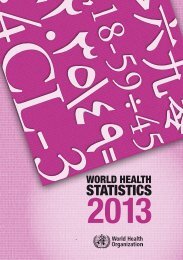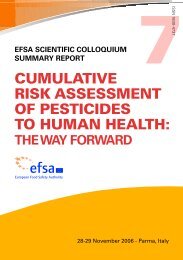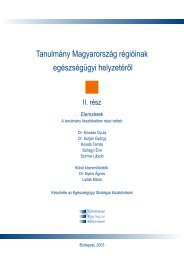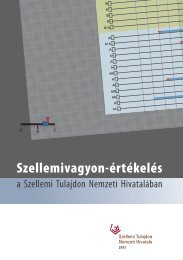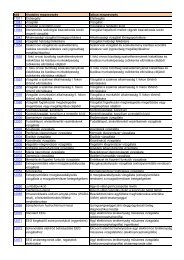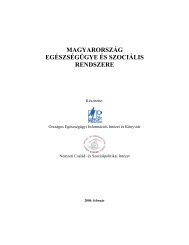Systematic review and evidence- based guidance ... - ECDC - Europa
Systematic review and evidence- based guidance ... - ECDC - Europa
Systematic review and evidence- based guidance ... - ECDC - Europa
Create successful ePaper yourself
Turn your PDF publications into a flip-book with our unique Google optimized e-Paper software.
<strong>Systematic</strong> <strong>review</strong> <strong>and</strong> <strong>evidence</strong>-<strong>based</strong> <strong>guidance</strong> on perioperative antibiotic prophylaxisTECHNICAL REPORTThe characteristics of the studies, their results <strong>and</strong> the grading of methodological quality/quality of <strong>evidence</strong> weresummarised 7 .Table 5. Distribution of included study design <strong>and</strong> geographical location of included studies,Objective 2Type of studyDistribution (world regions)Non-CBAs: n=16 (66.7%) North America: n=15Observational cohort studies: n=5 (20.8%) Europe: n=6RCTs: n=1 (4.2%) Asia: n=1ITS: n=1 (4.2%) Australia/New Zeal<strong>and</strong>: n=1Scoping <strong>review</strong>: n=1 (4.2%) Middle East: n=1Total: N=24A scoping <strong>review</strong> identified factors <strong>and</strong> interventions that can influence PAP administration [66]. A scoping <strong>review</strong>is conducted with rigor comparable to a systematic <strong>review</strong>, but examines a broader question by <strong>review</strong>ing a widerange of study designs. Gagliardi et al. included five studies which evaluated compliance with appropriateadministration of PAP as primary outcome, but did not evaluate the impact on SSI rate [66]. They concluded thatthe following measures improve compliance with appropriate PAP: implementation of multidisciplinaryprotocols/pathways; education or individualised performance feedback addressing clinician knowledge, attitudes,beliefs <strong>and</strong> behaviours; implementation of computerised decision-support programmes; <strong>and</strong> written orders for PAPkits, or pharmacist preparation of individualised PAP kits [66].In a RCT, Kritchevsky et al. investigated whether the implementation of a quality-improvement collaborativecombined with comparative feedback of performance data would increase compliance [67]. They included 44 USacute-care hospitals, each of which r<strong>and</strong>omly sampled approximately 100 selected surgical cases (cardiac surgery,hip or knee replacement, hysterectomy) at both the baseline <strong>and</strong> re-measurement phases. All hospitals received acomparative feedback report. Hospitals r<strong>and</strong>omly assigned to the intervention group (n=22) participated in aquality improvement collaborative comprising two in-person meetings led by experts, monthly teleconferences, <strong>and</strong>receipt of supplemental materials over nine months. The groups did not differ in the change in proportion ofpatients who received a properly timed antimicrobial prophylaxis dose (−3.8 percentage points [95% CI, −13.9–6.2]) after adjustment for region, hospital size, <strong>and</strong> surgery type. Similarly, the groups did not differ in individualmeasures of antibiotic duration; use of appropriate drugs; receipt of a single preoperative dose; or an all-or-nonemeasure combining timing, duration <strong>and</strong> selection. The authors assumed that the hospitals volunteered for theeffort were motivated to change. They concluded that all included hospitals improved their compliance data forthese PAP measures by receiving a performance feedback that could not significantly improve by additionalparticipation in a quality-improvement collaborative.A CBA study by Ritchie et al. with moderate study quality was conducted in the orthopaedic service of twohospitals in New Zeal<strong>and</strong> [68]. In order to reduce non-indicated, prolonged administration of PAP >24 h in patientsundergoing hip fracture surgery, a pre-printed prescription sticker was introduced <strong>and</strong> applied to the medicationchart by the anaesthetist when the initial dose of antibiotic was given. The number of patients who received threedoses according to the hospital guidelines increased from 29% to 74% (p



